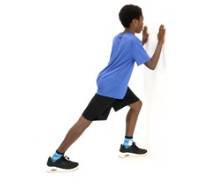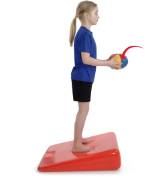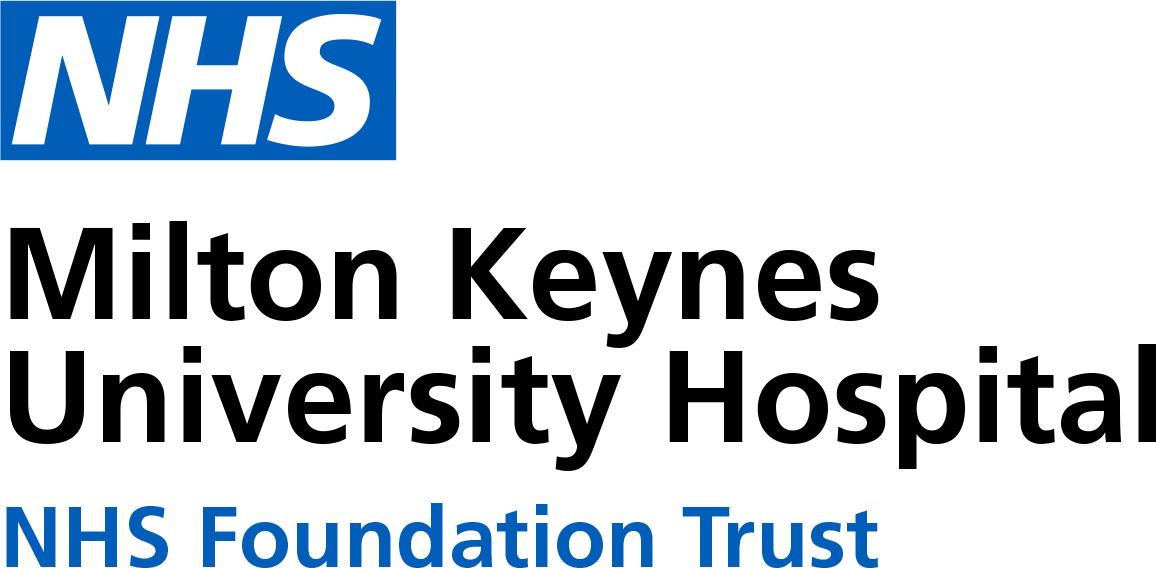Last Modified: 2:43pm 08/04/2024
For patients
There are a variety of conditions that we see and treat. Please see below for further information relating to a specific condition.
► Tip toe walkers
Under three’s
Children under the age of three will often walk on their tip toes. Sometimes there can be a family history of walking on tip toes. In most cases, there is nothing to worry about and this can be considered a ‘normal variant’; something that is commonly seen in typically developing children. Usually, toe walking will resolve.
If walking on the toes persists, the calf muscles can become tight and then it can be even harder for children to get their heels down. This is why it is helpful to discourage it.
If your child is able to stand with the heels down, there are things you can do to help prevent toe walking:
- Try to encourage activities that keep the heels down such as making footprints in sand or footprint painting. Try drawing around your child’s feet!
- Try walking along a line as if on a tightrope
- Standing on one leg
- Ask the child if they can walk on their heels like a penguin (keeping the toes off the floor)
- Get some stiff/sturdy boots for the child to wear. This should help to decrease the toe walking. Have the child wear the boots, indoors and outdoors, to try to break the habit.
- Calf stretches – try some simple calf stretches as shown in the pictures below. Ensure that the toes/feet are facing forward for these stretches.
 |
 |
If your child is unable to stand with their heels down, they will need to be seen for an assessment.
Older children
For older children who have been walking on their tip toes for a long time, the calf muscles may have become so tight that they are unable to get their heels down. These children will need to be seen for an assessment. If the child can get the heels down, try some calf stretches a shown in the pictures above.
Treatment
There is no single accepted treatment for toe walking. Treatment options can vary and include monitoring only, calf stretches, wearing orthotics, wearing a cast or serial casting, lengthening the calf muscles (surgery).
Some children will habitually toe walk, even when they are able to walk with their heels down. This usually subsides and rarely persists into adulthood.
► In-toeing gait or ‘pigeon toes’
Walking with the feet turned in is common in children under eight. It can result in more frequent falls as children can trip over their own feet. In most children the in-toeing resolves, without treatment, before the age of 10.
Causes
In-toeing can be caused by several factors:
- Femoral anteversion – the thigh bone rotates inwards (the whole leg turns in)
- Tibial torsion – the tibia bone rotates in (the knee is straight but the leg looks turned in at the ankle)
- Metatarsus abductus – the foot bends inwards (the outside boarder of the foot will be curved).
If your child is in-toeing, try some of the following suggestions:
- Sitting with legs crossed or with the soles of the feet together (butterfly sitting) and avoid ‘W’ sitting
- Wear good fitting, supportive footwear
- Try activities that encourage external rotation such as ballet, horse-riding or swimming breaststroke.
► Clubfoot
► Out-toeing gait (walking with the feet turned out)
Walking with the feet turned out is very common in children. This usually resolves by the age of four. You should be seen by a health professional if there is a sudden change in the way that your child walks. Also seek advice if only one leg turns out.
► Flat feet
Most adults will have an arch that runs along the inside of the foot. People who don’t have this, where the inside boarder of the foot is in contact with the floor, are said to have flat-feet. This is also called pes planus.
Flat feet are very common in children under the age of six. There are several reasons for this:
- Children have more fatty tissue in their feet, making it harder to see an arch
- There are lots of ligaments in the feet which are more flexible in children, so the foot shape flattens out more when the child is weight-bearing through the feet
- The arch develops over time. All children under the age of three will have flat feet as the arch has not developed. After the age of six, an arch may be more visible.
Generally, unless your child complains of pain, they will not need to be seen or treated by a health professional if they are under the age of six. Often, if the child stands on tip toes, or if the big toe is raised in standing, an arch forms.
Older children who have flat feet may need to be seen by a health professional, particularly if there is pain or stiffness in the feet.
If your child’s feet look different, for example if one side has an arch and the other doesn’t, this should be checked by a health professional. Also, if the arch is so flat that the back of the heel does not look straight, then this may need to be checked by a health professional.
Treatment
Sometimes flat feet can cause pain, or lead to other problems such as knee or hip pain. Treatment may include orthotic insoles, to support the arches of the feet, or exercises. Rarely, in older children, the bones in the foot can become fused and surgery is required.
► Knock knees
Knock knees or genu valgum is common in young children. This usually resolves, without treatment, by the age of six.
Between the ages of two and four it is normal for there to be a gap between the ankles of 6-7 cm (when the knees are together). The legs usually appear straighter as the child gets older.
► Bow legs
Bow legs (or physiologic genu varum) is when the legs bow leaving a gap between the knees when the ankles are together.
This is thought to be normal in typically developing children up until the age of two, where the legs will then start to straighten out. Children may even become slightly knock-kneed before they straighten out fully. This is also considered to be part of normal development and is nothing to worry about.
There are some cases of bow legs that require further investigation. Please see a specialist (such as a paediatric physiotherapist or paediatric orthopaedic consultant) if your child has any of the following:
- Leg pain
- Asymmetry of the legs where one leg is bowed and the other is straight, or if one leg is more bowed compared to the other
- Bowing of the legs after the age of two, and you don’t feel that it is correcting naturally
- The distance between the knees when the ankles are together is more than 6 cm.
► Growing pains
Growing pains do exist although the exact cause is unknown. Growing pains occur in the evening or at night-time in children aged between 3-12 years. The pain should be gone in the morning and it should not affect activities during the day. The pain is usually symmetrical (occurring on both sides) and most commonly affects the legs and feet. The pain is usually a dull ache and it does not typically affect the joints (ankles, knees or hips). A child with growing pains will feel well and will not have a temperature. Growing pains at night will often be worse after a busy/active day. There should not be any swelling or redness with growing pains and the way a child walks should not be affected (they will not limp).
Joint pain requires further investigation, particularly if it is present on waking.
Treatment for growing pain
Growing pain will resolve without treatment. There may be periods where the pain gets worse (during rapid growth). If growing pains are affecting sleep, a hot pack or warm bath may help. Massaging the muscles gently may also help. Occasional children’s paracetamol may be helpful, particularly after an active day.
► Hypermobility
Hypermobility is defined as having greater than expected ranges of movement in a joint. This may affect one or more joints but usually affects both sides. Typically, children are more flexible in their joints compared to adults. This is because their ligaments have more elasticity in them. We tend to get a bit stiffer in our joints as we get older. Some children who have hypermobility may not continue to have hypermobility when they reach adulthood. Hypermobility generally affects girls more than boys and it does not usually cause problems. For some, it can be advantageous such as those who do gymnastics or ballet. Hypermobility can be inherited.
Some children who have hypermobility can complain of aches and pains around the joints. If there is a lot of flexibility around the ankles, wearing good fitting supportive shoes or boots can help. In young children, taking breaks during long walks can be helpful. Distraction can also help such as playing counting or spotting games when walking. Hypermobility does not cause redness or swelling in the joints. If this occurs, your child will need to see a medical professional.
Hypermobility can be associated with other conditions. If there are concerns regarding a child’s coordination, balance or handwriting, you may want to seek an opinion from a healthcare professional. You may also need to seek advice if you feel that your child’s daily activities are affected by their increased joint mobility.
Treatment
There is no specific treatment for hypermobility but keeping the muscles around the joints strong is helpful. Activity should be encouraged and if children get tired quickly then a little and often approach works best. Wearing good supportive footwear is also helpful. A referral to a specialist may be helpful in severe cases, for example where daily activities are affected or if there are recurrent joint dislocations.
► Perthes
Perthes disease is a condition which affects the blood supply to the hip joint. This causes the ball part of the ball-and-socket hip joint to become flattened. This can affect the movement in the joint and may, in some cases, lead to difficulties such as arthritis later in life. The cause of the condition is unknown, but it appears between the ages of 5-12 and more commonly affects boys. This is a self-limiting condition, meaning the disease process will stop, but damage to the structure of the hip is likely to remain. One hip is usually affected but there can be cases where both sides have the disease.
Symptoms
- Hip pain or groin pain
- Thigh or knee pain (hip pain can often refer to the knee)
- Walking with a limp
- Restricted movement in the hip/stiffness in the hip.
Treatment
Anyone with Perthes disease will need to be under the care of an orthopaedic consultant. Treatment can sometimes be just watching and monitoring the disease progress. In some cases, surgery may be required. Activity modification is likely to help limit damage to the hip joint whilst the disease is active. Some children may be advised to be non-weight bearing for a period of time. Physiotherapy exercises may be advised to keep the joint moving.
► Slipped upper femoral epiphyses
A slipped upper femoral epiphyses can also be called a SUFE or a slipped capital epiphyses. The cause is largely unknown, but this condition occurs during growth between the ages of 10-17 (boys) and 8-15 (girls). It is more common in boys. Children have growth plates at the end of their bones and a SUFE occurs when the ball-shaped head of the thigh bone (femur) slips backwards on the femoral neck. It is essentially a fracture through the bone at the growth plate but it is not always caused by trauma.
Symptoms
- Hip/groin pain
- Walking with a limp
- The foot may be turned outwards and the leg may appear slightly shorter on the affected side
- The hip may have a restricted range of movement compared to the other side.
Treatment
A SUFE will need to be treated by an orthopaedic surgeon. A screw is placed into the bone to keep the femoral head in the correct place. This will also prevent any further slipping.
► Scoliosis
Scoliosis is a curvature in the spine. There are some conditions that are associated with scoliosis such as cerebral palsy or some neuromuscular conditions. In many cases however, the scoliosis is idiopathic, meaning that it just happens and there is no known cause. Idiopathic scoliosis usually occurs during early adolescence. The severity of the curvature can vary from mild to severe and in some rare cases, it may affect the respiratory system. Girls and boys are equally likely to get scoliosis but it is more frequently mild in boys.
Mild forms of scoliosis often don’t require treatment, however yearly monitoring may be required until growth is complete. Those who have a more significant curve may require brace treatment, surgery to control growth of the spine or even surgical correction. Treatment choice will depend on the age of the child, severity of the curve and the likelihood of the curve progressing.
It is important that where possible children/adolescents with scoliosis remain active to maintain flexibility and muscle strength and health of the heart and lungs.
